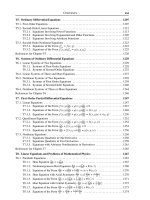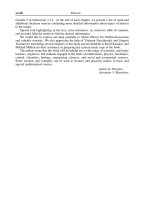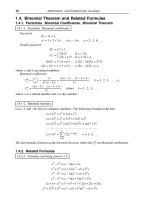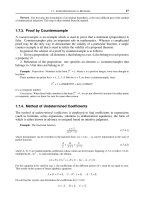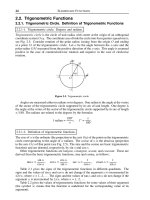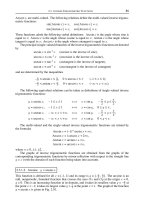Handbook of mathematics for engineers and scienteists part 55 ppsx
Bạn đang xem bản rút gọn của tài liệu. Xem và tải ngay bản đầy đủ của tài liệu tại đây (405.16 KB, 7 trang )
346 SERIES
Remark. The Kummer transformation is used for accelerating convergence of series, since the generic
term a
(1)
n
=
1 –
1
K
b
n
a
n
a
n
of the transformed series (8.1.5.7) tends to zero faster that the generic term {a
n
}
of the original series (8.1.5.5): lim
n→∞
a
(1)
n
/a
n
= 0. The auxiliary sequence {b
n
} is chosen in such a way that
the sum (8.1.5.6) is known beforehand.
2
◦
. Abel transformation:
∞
n=1
a
n
b
n
=
∞
n=1
(a
n
– a
n+1
)B
n
, B
n
=
n
k=1
b
k
.
Here, it is assumed that the sequence {B
n
} is bounded and lim
n→∞
a
n
= 0 (for example, these
conditions are satisfied if the sequence {a
n
} has finitely many nonzero terms).
Remark. The Abel transformation is used for accelerating convergence of series whose convergence is
slow (if lim
n→∞
a
n+1
/a
n
= 1 and b
n
= O(1)).
8.1.6. Infinite Products
8.1.6-1. Convergent and divergent infinite products.
An infinite product is an expression of the form
a
1
a
2
a
3
···=
∞
n=1
a
n
(a
n
≠ 0),
where a
n
are real (in the general case, complex) numbers. The expression
p
n
= a
1
a
2
···a
n
=
n
k=1
a
k
(8.1.6.1)
is called a finite product.
One says that an infinite product is convergent to p if there exists a finite nonzero limit
of the partial products:
lim
n→∞
n
k=1
a
k
= p.(8.1.6.2)
If there is no such limit, or p = ∞,orp = 0, one says that the infinite product is divergent.
In the last case one says that the infinite product diverges to zero (p = 0).
The simplest examples of infinite products
∞
n=1
a
n
:
for a
n
= 1 the infinite product is convergent, p
n
→ 1;
for a
n
=(–1)
n
the infinite product is divergent, p
n
has no limit;
for a
n
= n the infinite product is divergent, p
n
→∞;
for a
n
= 1/n the infinite product is divergent to zero, p
n
→ 0.
8.1. NUMERICAL SERIES AND INFINITE PRODUCTS 347
8.1.6-2. Infinite products with positive factors.
Taking logarithm of relation (8.1.6.1), one can reduce the problem of convergence of infinite
products with positive factors a
n
to the problem of convergence of partial sums of numerical
series:
s
n
≡ ln p
n
=
n
k=1
ln a
k
.
Therefore, in order to examine convergence of infinite products, one can use the convergence
criteria for infinite series considered in Subsections 8.1.2–8.1.3 (with a
n
replaced by ln a
n
).
In a similar way, one can examine convergence of infinite products containing finitely
many negative factors (infinite products with infinitely many negative factors are divergent;
see Corollary in Paragraph 8.1.6-3). To that end, one should consider the part of the infinite
product with positive factors.
8.1.6-3. Necessary condition for an infinite product to be convergent.
If an infinite product
∞
n=1
a
n
is convergent, then lim
n→∞
a
n
= 1; if lim
n→∞
a
n
≠ 1, then the infinite
product is divergent. (This necessary condition is insufficient to ensure convergence of a
product.)
C
OROLLARY.
For a convergent infinite product, there is
N
such that
a
n
> 0
for all
n > N
(i.e., a convergent infinite product can have only finitely many negative factors).
8.1.6-4. Convergence criteria for infinite products.
In the criteria given below, Δ
n
denotes the difference of the factor and its limit, which is
equal to 1 (see the above necessary condition of convergence):
Δ
n
= a
n
– 1.
T
HEOREM 1.
Suppose that for sufficiently large
n
, the difference
Δ
n
does not change
sign. Then the infinite product
∞
n=1
a
n
is convergent if and only if the series
∞
n=1
Δ
n
(8.1.6.3)
is convergent.
THEOREM 2.
If series (8.1.6.3) and the series
∞
n=1
Δ
2
n
are convergent, then the infinite product
∞
n=1
a
n
is convergent. (Here, the difference
Δ
n
may
change sign.)
348 SERIES
THEOREM 3(AN ANALOGUE OF THE D’ALEMBERT THEOREM).
Suppose that the terms
of an infinite product satisfy the necessary condition of convergence, i.e.,
a
n
→1
as
n →∞
,
and there exists the limit (finite or infinite)
lim
n→∞
Δ
n+1
Δ
n
= lim
n→∞
a
n+1
– 1
a
n
– 1
= D.
Then, for
D < 1
the infinite product
∞
n=1
a
n
is convergent, and for
D > 1
it is divergent. (For
D = 1
, this criterion is inapplicable.)
8.1.6-5. Absolute convergence of infinite products.
An infinite product
∞
n=1
a
n
is said to be absolutely convergent if the product
∞
n=1
(1 + |Δ
n
|)is
convergent.
T
HEOREM 4.
An infinite product
∞
n=1
a
n
is absolutely convergent if the series
∞
n=1
|Δ
n
|
is convergent.
An infinite product is commutation convergent (i.e., its value does not depend on the
order of its factors) if and only if it is absolutely convergent.
8.2. Functional Series
8.2.1. Pointwise and Uniform Convergence of Functional Series
8.2.1-1. Convergence of a functional series at a point. Convergence domain.
A functional series is a series of the form
u
1
(x)+u
2
(x)+···+ u
n
(x)+···=
∞
n=1
u
n
(x),
where u
n
(x) are functions definedonasetX on the real axis. The series
∞
n=1
u
n
(x) is called
convergent at a point x
0
X if the numerical series
∞
n=1
u
n
(x
0
) is convergent. The set of all
x
X for which the functional series is convergent is called its convergence domain.The
sum of the series is a function of x defi ned on its convergence domain.
In order to find the convergence domain for a functional series, one can use the con-
vergence criteria for numerical series described in Subsections 8.1.2 and 8.1.3 (with the
variable x regarded as a parameter).
Aseries
∞
n=1
u
n
(x) is called absolutely convergent on a set X if the series
∞
n=1
|u
n
(x)| is
convergent on that set.
8.2. FUNCTIONAL SERIES 349
Example. The functional series 1 + x + x
2
+ x
3
+ ··· is convergent for –1 < x < 1 (see Example 1 in
Subsection 8.1.1). Its sum is defined on this interval, S =
1
1 – x
.
The series
∞
k=n+1
u
k
(x) is called the remainder of a functional series
∞
n=1
u
n
(x). For a
series convergent on a set X, the relation S(x)=s
n
(x)+r
n
(x)(s
n
(x) is the partial sum of
the series, r
n
(x) is the sum of its remainder) implies that lim
n→∞
r
n
(x)=0 for x X.
8.2.1-2. Uniformly convergent series. Condition of uniform convergence.
A functional series is called uniformly convergent on a set X if for any ε > 0 there is N
(depending on ε but not on x) such that for all n > N, the inequality
∞
k=n+1
u
k
(x)
< ε holds
for all x
X.
A necessary and sufficient condition of uniform convergence of a series.Aseries
∞
n=1
u
n
(x) is uniformly convergent on a set X if and only if for any ε > 0 there is N
(independent of x) such that for all n > N and all m = 1, 2, , the inequality
n+m
k=n+1
u
k
(x)
< ε
holds for all x
X.
8.2.2. Basic Criteria of Uniform Convergence. Properties of
Uniformly Convergent Series
8.2.2-1. Criteria of uniform convergence of series.
1. Weierstrass criterion of uniform convergence. A functional series
∞
n=1
u
n
(x) is uni-
formly convergent on a set X if there is a convergent series
∞
n=1
a
n
with nonnegative terms
such that |u
n
(x)| ≤ a
n
for all sufficiently large n and all x X.Theseries
∞
n=1
a
n
is called
a majorant series for
∞
n=1
u
n
(x).
Example. The series
∞
n=1
(–1)
n
sin nx
n
2
is uniformly convergent for –∞< x < ∞,since
(–1)
n
sin nx
n
2
≤
1
n
2
,
and the numerical series
∞
n=1
1
n
2
is convergent (see the second series in Example 2 in Subsection 8.1.2).
2. Abel criterion of uniform convergence of functional series. Consider a functional
series
∞
n=1
u
n
(x)v
n
(x)=u
1
(x)v
1
(x)+u
2
(x)v
2
(x)+···+ u
n
(x)v
n
(x)+··· ,(8.2.2.1)
where u
n
(x)andv
n
(x) are sequences of functions of the real variable x [a, b].
350 SERIES
Series (8.2.2.1) is uniformly convergent on the interval [a, b]iftheseries
∞
n=1
v
n
(x)=v
1
(x)+v
2
(x)+···+ v
n
(x)+··· (8.2.2.2)
is uniformly convergent on [a, b] and the functions u
n
(x) form a monotone sequence for
each x and are uniformly bounded (i.e., |u
n
(x)| ≤ K with a constant K independent of n, x).
3. Dirichlet criterion of uniform convergence of functional series. Series (8.2.2.1) is
uniformly convergent on the interval [a, b] if the partial sums of the series (8.2.2.2) are
uniformly bounded, i.e.,
n
k=1
v
k
(x)
≤ M = const (x [a, b], n = 1, 2, ),
and the functions u
n
(x) form a monotone sequence (for each x) that uniformly converges
to zero on [a, b]asn →∞.
8.2.2-2. Properties of uniformly convergent series.
Let
∞
n=1
u
n
(x) be a functional series that is uniformly convergent on a segment [a, b], and let
S(x) be its sum. Then the following statements hold.
T
HEOREM 1.
If all terms
u
n
(x)
of the series are continuous at a point
x
0
[a, b]
,then
the sum
S(x)
is continuous at that point.
THEOREM 2.
If the terms
u
n
(x)
are continuous on
[a, b]
, then the series admits term-
by-term integration:
b
a
S(x) dx =
b
a
∞
n=1
u
n
(x)
dx =
∞
n=1
b
a
u
n
(x) dx.
Remark. The conditionof continuity ofthe functions u
n
(x)on[a, b] canbe replaced by a weaker condition
of their integrability on [a, b].
THEOREM 3.
If all terms of the series have continuous derivatives and the functional
series
∞
n=1
u
n
(x)
is uniformly convergent on
[a, b]
, then the sum
S(x)
is continuously differ-
entiable on
[a, b]
and
S
(x)=
∞
n=1
u
n
(x)
=
∞
n=1
u
n
(x)
(i.e., the series admits term-by-term differentiation).
8.3. Power Series
8.3.1. Radius of Convergence of Power Series. Properties of Power
Series
8.3.1-1. Abel theorem. Convergence radius of a power series.
A power series is a functional series of the form
∞
n=0
a
n
x
n
= a
0
+ a
1
x + a
2
x
2
+ a
3
x
3
+ ··· (8.3.1.1)
8.3. POWER SERIES 351
(the constants a
0
, a
1
, are called the coefficients of the power series), and also a series of
a more general form
∞
n=0
a
n
(x – x
0
)
n
= a
0
+ a
1
(x – x
0
)+a
2
(x – x
0
)
2
+ a
3
(x – x
0
)
3
+ ··· ,
where x
0
is a fixed point. Below, we consider power series of the first form, since the
second series can be transformed into the first by the replacement ¯x = x – x
0
.
A
BEL THEOREM.
A power series
∞
n=0
a
n
x
n
that is convergent for some
x = x
1
is absolutely
convergent for all
x
such that
|x| < |x
1
|
. A power series that is divergent for some
x = x
2
is
divergent for all
x
such that
|x| > |x
2
|
.
Remark. There exist series convergent for all x, for instance,
∞
n=1
x
n
n!
. There are series convergent only
for x = 0, for instance,
∞
n=1
n! x
n
.
For a given power series (8.3.1.1), let R be the least upper bound of all |x| such that the
series (8.3.1.1) is convergent at point x. Thus, by the Abel theorem, the series is (absolutely)
convergent for all |x| < R, and the series is divergent for all |x| > R. The constant R is
called the radius of convergence of the power series, and the interval (–R, R) is called its
interval of convergence. The problem of convergence of a power series at the endpoints
of its convergence interval has to be studied separately in each specific case. If a series is
convergent only for x = 0, the convergence interval degenerates into a point (and R = 0); if
a series is convergent for all x, then, obviously, R = ∞.
8.3.1-2. Formulas for the radius of convergence of power series.
1
◦
. The radius of convergence of a power series (8.3.1.1) with finitely many zero terms can
be calculated by the formulas
R = lim
n→∞
a
n
a
n+1
(obtained from the D’Alembert criterion for numerical series),
R = lim
n→∞
1
n
√
|a
n
|
(obtained from the Cauchy criterion for numerical series).
Example 1. For the power series
∞
n=1
3
n
n
x
n
,usingthefirst formula for the radius of convergence, we get
R = lim
n→∞
a
n
a
n+1
= lim
n→∞
n + 1
3n
=
1
3
.
Therefore, the series is absolutely convergent on the interval –
1
3
< x <
1
3
and is divergent outside that interval.
At the left endpoint of the interval, for x =–
1
3
, we have the conditionally convergent series
∞
n=1
(–1)
n
n
,andatthe
right endpoint, for x =
1
3
, we have the divergent numerical series
∞
n=1
1
n
. Thus, the series under consideration
is convergent on the semi-open interval
–
1
3
,
1
3
.
2
◦
. Suppose that a power series (8.3.1.1) isconvergent at a boundary point of its convergence
interval, say, for x = R. Then its sum is left-hand continuous at that point,
lim
x→R–0
∞
n=0
a
n
x
n
=
∞
n=0
a
n
R
n
.
352 SERIES
Example 2. Having the expansion
ln(1 + x)=x –
x
2
2
+
x
3
3
– ···+(–1)
n+1
x
n
n
+ ··· (R = 1)
in the domain –1 < x < 1 and knowing that the series
1 –
1
2
+
1
3
– ···+(–1)
n+1
1
n
+ ···
is convergent (by the Leibnitz criterion for series with terms of alternating sign), we conclude that the sum of
the last series is equal to ln 2.
8.3.1-3. Properties of power series.
On any closed segment belonging to the (open) convergence interval of a power series,
the series is uniformly convergent. Therefore, on any such segment, the series has all the
properties of uniformly convergent series described in Subsection 8.2.2. Therefore, the
following statements hold:
1. A power series (8.3.1.1) admits term-by-term integration on any segment [0, x]for
|x| < R,
x
0
∞
n=0
a
n
x
n
dx =
∞
n=0
a
n
n + 1
x
n+1
= a
0
x +
a
1
2
x
2
+
a
2
3
x
3
+ ···+
a
n
n + 1
x
n+1
+ ··· .
Remark 1. The value of x in this formula may coincide with an endpoint of the convergence interval
(x =–R and/or x = R), provided that series (8.3.1.1) is convergent at that point.
Remark 2. The convergence radii of the original series and the series obtained by its term-by-term
integration on the segment [0, x] coincide.
2. Inside the convergence interval (for |x| < R), the series admits term-by-term differ-
entiation of any order, in particular,
d
dx
∞
n=0
a
n
x
n
=
∞
n=1
na
n
x
n–1
= a
1
+ 2a
2
x + 3a
3
x
2
+ ···+ na
n
x
n–1
+ ··· .
Remark 1. This statement remains valid for an endpoint of the convergence interval if the series (8.3.1.1)
is convergent at that point.
Remark 2. The convergence radii of the original series and the series obtained by its term-by-term
differentiation coincide.
8.3.2. Taylor and Maclaurin Power Series
8.3.2-1. Basic definitions.
Let f(x)isaninfinitely differentiable function at a point x
0
.TheTaylor series for this
function is the power series
∞
n=0
1
n!
f
(n)
(x
0
)(x – x
0
)
n
= f(x
0
)+f
(x
0
)(x – x
0
)+
1
2
f
(x
0
)(x – x
0
)
2
+ ··· ,
where 0!=1 and f
(0)
(x
0
)=f (x
0
).



